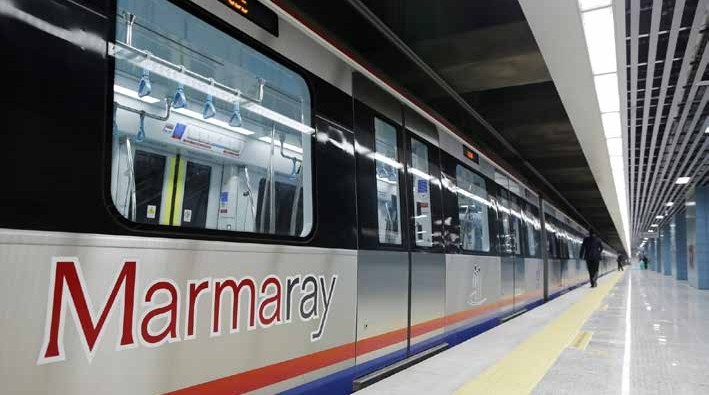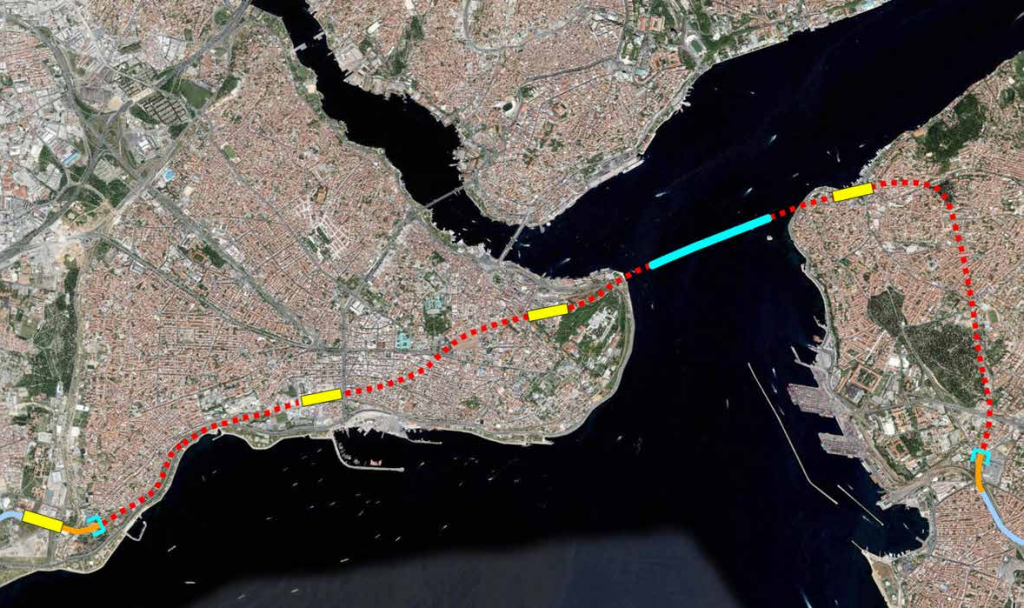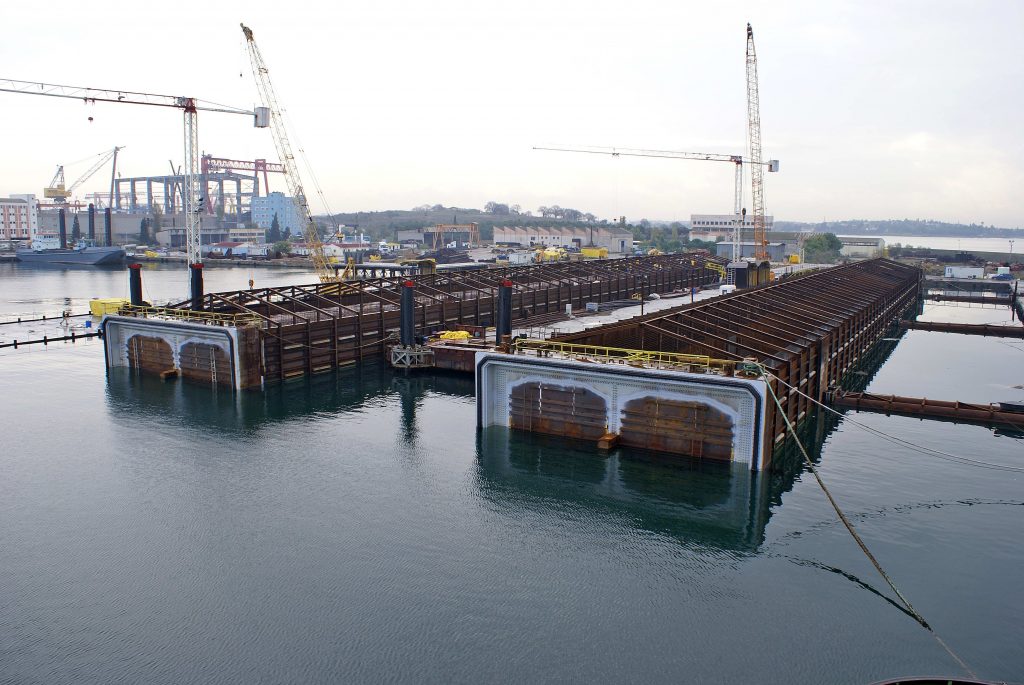DREAM CAME TRUE: MARMARAY “Bosphorus Intercontinental Railroad Tunnel “
World renowned GAMA Holding has been one of the makers of Turkey’s biggest projects and very first immersed tunnel, multidirectional and integrated commuter railroad project: Marmaray Bosphorus Intercontinental Railroad Tunnel.

Turkey’s Very First Immersed Tunnel Project
As a multidirectional and integrated commuter project that aims to solve heavy traffic problem of İstanbul, Marmaray allowed crossing the Bosphorus under the sea through a tunnel and turned the international and intercity railroads present in both sides into a metro system in 2013.
1st stage of Marmaray Railroad Project, Bosphorus Tunnel, Bosphorus Tube Crossing was undertaken by Japanese Taisei and GAMA-NUROL Partnership. Started in 2004, the project was planned to be completed in 4 years but out of respect for İstanbul’s history, it was completed in 9 years. The excavations carried out during the process led to unearthing archaeological artifacts. Thus, in addition to offering huge benefits to transportation sector, this project has also contributed to the archaeological history of the world through valuable pieces and information.
From TÜNEL-İ BAHRİ to MARMARAY
Due to being an important connection between Europe and Middle East, İstanbul has been the matter of interest of many different projects throughout the history. In Ottoman Era, Tünel-i Bahri (Sea Tunnel) connecting Üsküdar and Sarayburnu was one of the most important projects of the Palace. Yet the canal was too deep to be dealt with using 19th century engineering methods.
French engineer Simon Preault was the first to submit a proposal in the Ottoman Era for a “Tube Crossing” project that would connect Asia and Europe in 1891. Submitted in Sultan Abdulhamid era, this proposal was titled “Undersea Steel Tunnel.”
The total length of the tunnel was 3.1 kms in project while undersea tube crossing was 1.9 kms long.
11 years after Simon Preault, another tube crossing project was proposed by three American engineers: Frederic E. Storm, Frank T. Lindman and John A. Hilliker.


Titled “Cesr-i Enbubi fil bahr”, this proposal was submitted to Abdulhamid in 1902. It aimed to place a tube crossing over columns placed on the seabed to connect Yenikapı and Harem with train, Europe and Asia railways with another railway between Harem and Haydarpaşa.
American engineers received the certificate of “Tünel-i Bahri”. However, this project did not come to fruition.
The railway campaign started in the first years of the Republic continued at full speed in the following years. Mustafa Kemal Atatürk Pasha especially focused his efforts on the development of railways.
However, the railroads were left to their own devices in the 1950s as it was the era of highways and automobiles, although the infrastructure was lacking. Due to the increase in immigration during that time, urban transportation had become a massive issue especially in Istanbul. New roads were built to address the traffic issue but they were far from solving the problems created by unplanned growth of the city.
Towards the end of 1960s, the most important item on the public agenda was building a bridge over the Bosphorus.
Amidst the disputes, the foundation of the 1st Bosphorus Bridge was laid in 1970. When the 1st bridge was not able to solve the traffic problem of the city, 2nd and 3rd bridges were built. Bridges had positive effects on İstanbul. However environmental issues and traffic problems persisted.
In the 90s it was understood that İstanbul’s transportation problems could not be solved without public transportation projects. It was GAMA Holding’s late founding member Uğurhan Tunçata who brought forward the Marmaray Project to realize building a tube crossing under the Bosphorus, which was once a dream.
Following the feasibility study by Parson Brinckerhoff, the 1st stage of the Marmaray Project, which had been in discussion for many years, started in 2004 with grant financing from Japan. One of GAMA Holding Board Members, late Süreyya Yücel Özden gave Marmaray its name.

MARMARAY “The Project of the Century”
Being a first in the world, Marmaray connected Europe and Asia with a tunnel in İstanbul, the only city in the world that is spread across two continents.
Implemented to connect Halkalı on the European side and Gebze on the Asian side with an uninterrupted, modern and high-capacity suburban railway system, Marmaray Project was equipped with modern wagons and improved the suburban railway system in İstanbul with tube crossing under the Bosphorus.
The 1st stage which connects the railway lines on both sides of the Bosphorus was realized by the Japanese Taisei and GAMA-NUROL Partnership.
The line starts underground at Yedikule, proceeds along Yenikapı and Sirkeci stations underground, passes under the Bosphorus through an immersed tube crossing, connects to Üsküdar, another underground station, and finally surfaces at Ayrılıkçeşme Station. Aksaray-Airport, Yenikapı-Taksim-Hacıosman metro and tram lines were integrated with Kadıköy-Pendik, Üsküdar-Çekmeköy metro lines on the Asian side and formed the backbone of the rail transport in İstanbul.
The entire upgraded and newly built railway system is 76 kms long. The main structures and systems consist of improved lines and brand new electrical and mechanical lines including immersed tube tunnel, drilled tunnels, cut-and-cover tunnels, at-grade structures, 3 new underground stations, 37 above ground stations (renovated and improved), operational control centre, sites, workshops, maintenance facilities, and a new third line to be built above ground.
MARMARAY Has Become The Centre Of Intercontinental Commercial Freight Transport
Marmaray, one of the largest transportation infrastructure projects in the world, also plays an important role in uninterrupted freight transportation and serves domestic, international and transit freight transportation between 00.00 and 05.00. The transit line between Beijing and London has been passing through the Marmaray route since the Baku-Tbilisi-Kars railway line was completed in 2017.
After the first transit train from China to Europe used this route in November 2019, a new era in international rail freight transport has begun. Providing uninterrupted railway transportation between Asia and Europe, Marmaray has reduced the cost and duration of commercial freight transportation.

MARMARAY Has Become The Centre Of Intercontinental Commercial Freight Transport
Marmaray, one of the largest transportation infrastructure projects in the world, also plays an important role in uninterrupted freight transportation and serves domestic, international and transit freight transportation between 00.00 and 05.00. The transit line between Beijing and London has been passing through the Marmaray route since the Baku-Tbilisi-Kars railway line was completed in 2017.
After the first transit train from China to Europe used this route in November 2019, a new era in international rail freight transport has begun. Providing uninterrupted railway transportation between Asia and Europe, Marmaray has reduced the cost and duration of commercial freight transportation.
Marmaray hattı
An Engineering Achievement
As part of Marmaray project, the deepest laying immersed tunnel in the world was installed 60 meters deep in Bosphorus. Since it is only 20 kms away from the North Anatolian fault line, one of the most dangerous fault lines in the world, Marmaray was designed and implemented to survive a 7.5-magnitude earthquake with zero security risks, minimum loss of function, and no water leakage in immersed tunnel and conjunction points. In order to last for at least 100 years, 40 Mpa early-age, uncracked concrete was used as it is resistant to alkaline aggregate reaction, outdoor conditions, frost and chemical abrasion among other design criteria.
In addition to being the deepest immersed tube crossing in the world, Marmaray has another unique feature with its Üsküdar Station: Built under Üsküdar Square on the shore of Bosphorus, Üsküdar Station is on an area reclaimed from the sea. This area is approximately three football fields long and has half the width of a football field. Its depth underground is equal to the height of a ten story building. A building at such a depth on the seashore is not very common in the world.

Marmaray allowed passing the Bosphorus under the sea through a tube crossing and transformed existing railway lines on the boths sides into a metro system in addition to international transportation.
A New Urban Culture
Considering how precious time is for people living in the city, it is of great importance to know the duration of a journey. On the other hand, the ever-increasing density of urban traffic makes travel time incalculable. One of the long-term transformational results of Marmaray, which provides faster transportation service to its passengers and most importantly, “always the same time” guarantee, was creating a new “urban culture”. While providing easy access to business and cultural centres in İstanbul, Marmaray contributes to the liveliness of urban life and to its cultural and economic development.


Environment Friendly Approach, Environment Friendly Project
Using electrical energy, Marmaray does not cause air pollution. In addition, the proper waste management during the construction process made Marmaray an environment friendly project.
The underwater excavation and dredging processes of the project yielded approximately 1 million m3 of material such as sand, gravel and rock. This waste was moved kilometres away from the coast under the supervision of the Ministry of Environment. Marmaray has fulfilled the requirements of being a world-class project in terms of environmental awareness by ensuring that large amounts of waste were transported meticulously to the regions designated by the Ministry in order to prevent waste from descending to the seabed and polluting water resources.


MARMARAY Shed a Light On The History Of İstanbul
From the start of the project until the starting date of commercial train operations on 20.10.2013, construction works carried out above the traces of İstanbul’s history had to be paused for a long time due to archaeological excavations that took 9 years and 2 months. In addition to shedding light on the history of İstanbul, Marmaray also contributed illuminating the archaeological heritage of the world: 13 shipwrecks and more than 35 thousand archaeological artifacts were found during the archaeological excavations carried out within the scope of Marmaray Project.
In Yenikapı, the skeletons of early İstanbulites and footprints dating back to 8500 years (6500 BC) were unearthed, as well as the port of Thedesius, which was mentioned in the world literature but could not be found. Also known as the “Millenium Port,” shipwrecks were found in this port as well. The most remarkable of these wrecks, Lagan 12, was unearthed in its laden state. Prior to these findings, the history of İstanbul was thought to start 6000 years ago but with these findings, the history of İstanbul was revised to date back 8500 years. More than 40 thousand archaeological artifacts unearthed during the project meet the public through regular exhibitions. The entire collection is planned to be exhibited in the museum which will be built in Yenikapı.

An İstanbul Dream Came True: Marmaray
The process and detailed history of the Marmaray Project by TAISEI – GAMA – NUROL partnership has been compiled into a book by GAMA Holding as the project marks one of the milestones of our transportation industry. This book is not for sale but given as a gift upon request.
